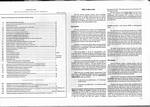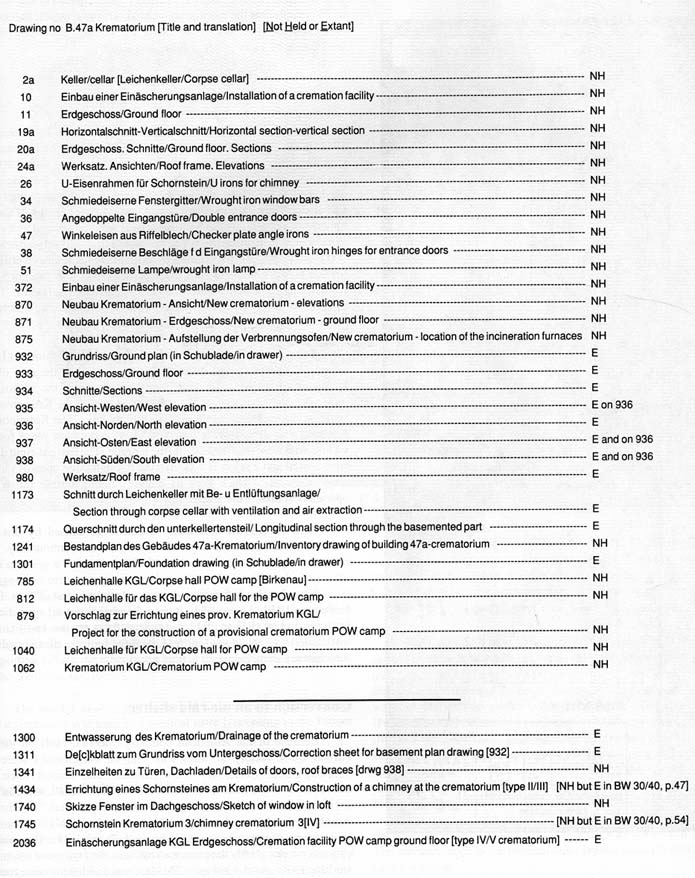|
|
 |
 |
AUSCHWITZ:
Technique
and Operation
of
the Gas Chambers © |
|
|
| |
 |
Back |
 |
Contents |
Page 131 |
 |
Home
Page |
Forward |
 |
| |
Document D1b and
D2b
[Pages 41 and 42 of the Bauleitung “Catalogue of
Drawings” : PMO File BW 1/4] |
| (Photos by the
author) |
 |
| |
| THE
FURNACES |
| |
This Topf drawing, showing a furnace with two cremation
chambers (also known as muffles) heated with coke by two hearths situated at
the near, was the basic model for the first two furnaces installed in
Krematorium I. Although shown on this drawing, the lateral pulsed air
installation does not seem to have been fitted to the furnaces according to
Topf Drawings D59042 [a and b].
Description
The upper opening [top left on section
A B in Drawing D57253] enabled one or more bodies to be introduced using
a charging trolley [Photos 22, 23, 24]. The ashes of the bodies were
collected through the lower orifice [visible lower left on Photo 24]. In
the case of registered prisoners, the ashes were placed in metal urns
[Documents F1 and F2]. The family were informed of the death
[Document F3], and could obtain the urn on request, after paying the
“costs” of cremation. Since the cremations were often collective, it
was virtually impossible that the urn received by the family would contain the
right ashes.
The hearth was fed with coke and the cinders were removed
from behind the furnace, in a small pit reached by a stairway [right hand side
of section A B on Drawing D57253]. The smoke reached the external
chimney via underground flues.
Topf Drawing D59042 [a and b] of
25th September 1941 is concerned with the installation of a third two muffle
furnace, known as the “new furnace”, also with a lateral pulsed air
installation which was installed as indicated in the furnace operating
instructions provided by Topf [Documents G1a and b, G2a and b].
The trolley for charging the bodies into the furnace was operated as
perfectly described by Henryk TAUBER in his deposition of 24th May 1945 [Part
III, Chapter 3]. The main problem with this trolley was that it tended to tip
up when the charging trough or slide was loaded with several corpses. This
“nose down” tendency meant that this type of trolley was abandoned in
Krematorien Il and III in favor of a “Leichenbrett / corpse
stretcher” that was easier to handle.
Filled with three two muffle
furnaces. Krematorium I could incinerate up to 340 corpses in 24 hours,
according to a Bauleitung letter of 28th June 1943 (31550/Ja/Ne). This was a
PRACTICAL THROUGHPUT achieved as follows: |
| |
— For the first two two muffle furnaces: 1.5
to 2 bodies per muffle per hour;
— For the new two muffle furnace: 3
to 4 bodies per muffle per hour. |
The coke consumption of the three furnaces was estimated
three furnaces was estimated at about 1000kg per 12 hours of per 12 hours of
operation, calculated on the basis of a Bauleitung note (Aktenvermerk) of
17th March 1943 (24757/43/Jä/Lm) [file BW 30/34. page 54]. The third
furnace was the prototype for the future three muffle furnace designed by Kurt
Prüfer, chief engineer at Topf, ten of which were built and installed in
Birkenau Krematorien II and III. This furnace entered service in December 1941
[Documents HI and H2].
The initial chimney was of circular
section, but as the result of damage it was replaced by one of square
section. The date of this transformation, before September 1941, is not
known. Between the furnace room and the chimney there was a shed housing the
motor for the collective forced draught installation for the three furnaces
[Documents G3a, b and c].
Layout
[according to Topf drawing D59042 of 25th September 1942]
The main
entrance door (north west) opened onto a vestibule leading to the furnace room.
This included two rooms in annex: a coke store with its own entrance from
outside containing a little office [which no longer exists] and an urn room.
Entering the vestibule from outside, the first door on the right opened on a
laying out room [which now contains the oil fired cremation furnace from the
Trzebinia labor camp], the left hand door [bricked up since 1944] opened onto
the third furnace and, finally, the second door on the right opened onto the
washing room communicating directly with the “Leichenhalle” or morgue
that communicated with the furnace room through another door.
The
bodies of dead prisoners should have taken the circuit: laying out room,
washing room and morgue, where they would be stored while awaiting cremation.
In fact, they were directly stocked in the morgue. The delay between death and
cremation was three or four days [Documents F1 and F2]. Their ashes,
theoretically deposited in individual urns, were sent to the family at the
latter’s expense.
The morgue
From an “ordinary” morgue it gradually became a
place for “knocking over”, a term designating execution by shooting
in the back of the neck with a small caliber firearm, a practice used by the
Political Section of the camp on those it condemned. Rather than transporting
to the Krematorium the bodies of prisoners executed in the yard between Blocks
10 and 11, at the other end of the camp, much effort was saved by taking the
victims directly on foot from Block 11 to the morgue of the Krematorium and
shooting them there.
At the end of 1941 the morgue was transformed into
a homicidal gas chamber operating on Zyklon B, the regulation
hydrocyanic acid disinfection agent used by the Wehrmacht, produced by Degesh
and distributed in the east of the Reich by Tesch und Stabenow (Testa).
The present area of the gas chamber is 98m², including the airlock
at the south east end. Initially, it covered 78m² and had a volume of
224m³ [or a little less than half the volume of the gas chambers in
Krematorien II and III]. The two gas tight doors, one opening on the furnace
room and the other on the washing room, had three thicknesses of board and were
sealed with felt [one of these gas tight doors with no peephole is visible
leaning against the wall where the third furnace used to be]. In the ceiling
there were at least three openings for pouring Zyklon B [Photo 14] which
was thrown in directly and scattered |
|
| |
AUSCHWITZ:
Technique and operation
of the gas
chambers
Jean-Claude Pressac
© 1989, The Beate Klarsfeld Foundation |
 |
Back |
Page 131 |
Forward |
 |
|

